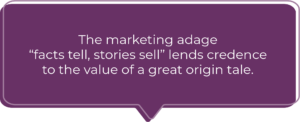Family Business Branding: Making the Most of Your Origin Story

When it comes to branding, many family businesses are sitting on an enviable asset: an authentic origin story built around the vision, passion, struggles and quirks of the individuals who first brought the enterprise to life.
In an era where many brands are “born” through the sterile science of corporate market research, a true family backstory is a rare treasure. But how to make the most of it? Whether you’re launching a new brand or stewarding an already-established family business, consider these tips to get the greatest value from your one-of-a-kind authentic backstory.
A great story should grow with you.
First, remember that brands are living entities, and so are the stories behind them. So, while the core facts of your family business origin will of course hold constant, the best way to frame your story can and should evolve over time to meet changing business realities – and it’s never too early to set the stage for this longevity. For example, The Ball Brother Glass Manufacturing Company of the 19th Century, which launched the Ball Mason Jar, one of America’s most iconic and recognizable brands, has morphed over 150 years into today’s diversified global manufacturing and aerospace company with nearly $14 billion in annual revenues. While the Ball name is shared by both, the company’s brand story has evolved dramatically.
For newer organizations, we encourage the thought experiment of reimagining your origin story from the perspective of the family business you aspire to build over the coming years, rather than the one you are operating today. That larger vision may elevate your thinking and unlock a far more compelling narrative.
Also, if the business is new and succession beyond the founder remains uncertain, it may be advisable to frame the brand as a product of the family collectively, rather than a single individual. Similarly, if your portfolio expansion roadmap is unclear, avoid needlessly aligning your brand story too tightly to a single product or ingredient, which can result in “storying yourself into a corner.”

Wield your story’s power strategically.
The marketing adage “facts tell, stories sell” lends credence to the value of a great origin tale. But the specific role of the origin story in your overall brand communication strategy merits careful consideration. Since effective brand storytelling depends on simplicity, throwing too many messages at your audience without defining the purpose of each can be risky.
As valuable as a family origin tale is, it rarely makes sense as a lead message in ads or selling pages intended to drive purchase. More often, a family backstory truly shines as a discoverable second-level proof point, best deployed after your audience has already been hooked by the unique value proposition of your brand and products.
In media relations and brand journalism, however, this hierarchy may be reversed. When a consumer learns that a new product comes from a family of rebel culinary innovators with a unique sustainability spin, for example, he or she may not necessarily be driven to purchase in the moment. But they’ll likely be impressed and curious to know more — and that intrigue factor can have immense brand-building power over time. A great example of this is the recent extension of the iconic Jelly Belly candy brand into Jelly Belly Sparkling Water, an emerging powerhouse in the $4 billion U.S. flavored seltzer category led by members of the original Jelly Belly founding family, the Joffers.

What about the family name?
There was a time when every family business automatically took the family name. Today, the options are endless, and we encourage clients launching an enterprise to embrace that freedom, explore broadly and think through the name in a larger strategic context. We encourage our clients to engage outside professional creative support to guide this process.
Of course, the question of whether to lend your family name to your brand may carry a lot of emotional weight. But in truth much of the power of any brand name, family or otherwise, comes from the story and associations built around it over time through effective marketing and storytelling. There’s no inherent magic — nor inherent risk — in choosing a family name for your brand.
That said, keep in mind that all words carry certain natural linguistic associations, and family names are no exception. Brands derived from traditional surnames naturally set a historical tone, suggesting traits like craftsmanship and quality. (Just think of category heroes like Nielsen-Massey, Barilla and Brooks Brothers.) First names like Justin’s and Lily’s are inherently casual and approachable and tend to feel like small boutique operations, whether or not that’s actually the case. Many successful brands, including Walmart, have grown from creative coinages that reference the family name, but don’t claim it outright. And of course, brands whose names carry no explicit family connection can still embody a delightful origin story, as is the case with Internet giant Google, which was originally called Backrub but changed its name when co-founder Larry Page accidently misspelled the number “Googol,” a digit followed by 100 zeros.
As a family business ourselves, Wilks Communications Group has a special affinity for authentic family brand origin stories. To learn more about how we might help tell yours for maximum business impact, get in touch!